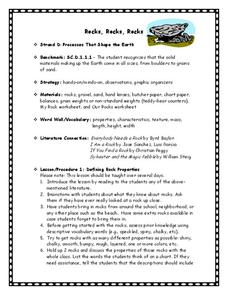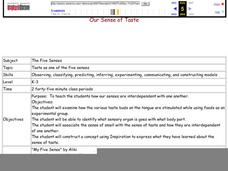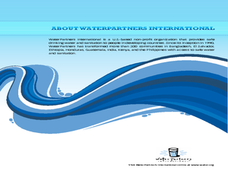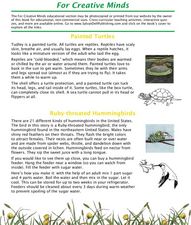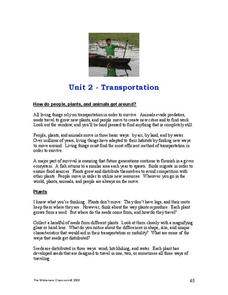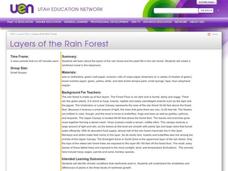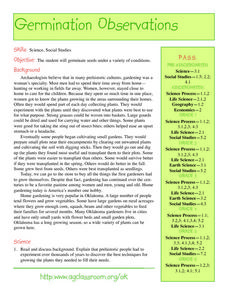Curated OER
Habitat, What is That?
Students explore animal habitats. In this environmental stewardship lesson, students match animals to their habitats in a classroom activity. Students also observe a firefly habitat and read Fireflies. Students create bulletin boards...
Curated OER
Butterfly Metamorphosis
Young scholars read a story, watch a video, and interact with a butterfly website to learn about butterfly metamorphosis. In this butterfly lesson plan, students listen, discuss, and participate in activities relating the metamorphosis...
Curated OER
Wind Power: From Eyesore to Energy
Young scholars design their own wind turbine according to client's needs. In this science and technology lesson, students analyze the pros and cons of using wind power. They construct a model of their proposed wind turbine and present it...
Curated OER
Ocean -- Under The Sea
Young scholars participate in hands-on activities dealing with what lives in the ocean. They also read literature about the oceans.
Curated OER
Show 303: New Research into Dyslexia
Learners explore the causes of dyslexia. They view CT sans and MRIs to view the brain and how it responds. Students read reports about dyslexia. They discuss the nature of dyslexia, its cause, how to diagnose it, and its permanency.
Curated OER
Rocks, Rocks, Rocks
Students are introduced to how the different types of rocks formed. As a class, they are read a book about rocks and create a list of what they already know about them. Using examples of rocks they find around the school, they discover...
Curated OER
Our Sense of Taste
Young scholars explore the relationship between the senses of taste and smell using a blindfold taste test. In partners, they taste different foods with their noses plugged and unplugged. They create a life size outline of the human...
Curated OER
Traveling for Water
Students explore global water contamination and water shortage problems. For this geography/ecology lesson, students gain information about the lack of safe drinking water in many countries. Students read, use websites, and complete...
Curated OER
Our Five Senses Affect Food Choices
Students read My Five Senses: A Lion's Tale. In this five senses lesson, students understand the relationship between their five senses and how they affect their food choices. Students write journal entries about their senses and the...
Curated OER
For Creative Minds: Tudley Didn't Know
Students discover facts about the animals in John Himmselman's book, Tudley Didn't Know, and make a paper turtle. In this marsh animals lesson, students first read the book Tudley Didn't Know. Students read facts about painted turtles,...
Curated OER
The Sharp Adaptations of Porcupines
In this porcupine worksheet, students learn about how porcupines adapt to their lives in the woods and how they use their quills. After reading a short text and analyzing the labeled pictures, students answer 3 short answer questions.
Curated OER
Transportation
Students read about various modes of transportation for people, plants, and animals. In this transportation lesson, students read information about the transportation modes for people plants, and animals using water and land. Students...
Curated OER
Organs and What They Do - Lecture
Students read information about the internal organs and body systems. In this organs and systems lesson, students read descriptions of the heart, lungs, stomach, small and large intestine, and liver and gall bladder. Students study...
Curated OER
Barnyard Sounds
Students match pictures of barnyard animals with the sound that they make. In this barnyard animals lesson plan, students read books, and retell barn stories.
Curated OER
Layers of the Rainforest
Third graders identify, compare, and contrast the rainforests' climates. After reading Jane Yolen's Welcome to the Green House, they create a rainforest bulletin board.
Curated OER
Reptile and Amphibian Defense Strategies
Students study the stages of the Eastern newt either by collecting a live specimen or from pictures. They note the colors of the eft stage before reading the "Eastern Newt Species Account" that shows the newt's life stages, migration,...
Curated OER
The Amazon Rain Forest
Fifth graders perform a play about the Amazon Rain Forest. They practice assigned parts and sing a song about the Rain Forest. They create costumes for the characters and discuss the role each character plays. They perform the play...
Curated OER
Germination Observations
Students germinate seeds under a variety of conditions. First, students read and discuss the background of gardening. After reviewing germination and the steps to the scientific method, groups of students complete experiments.
Curated OER
Chromosomes and Genetic Mapping
Learners create models of chromosomes using clay, coins, beads, or marbles. They complete a worksheet regarding their crossover frequencies they created with their chromosomes and gene models. They read an essay on sex chromosomes and...
Curated OER
Explorations Through Time
In this earth history worksheet, high schoolers visit a website and complete 15 fill in the blank and 8 short answer questions based on what they read. Topics include biodiversity, animal kingdoms, evolution, fossils, and extinction.
Curated OER
Duck
In this ducks worksheet, students read information paragraphs about the habitat, reproduction, feeding and adaptation of ducks. Students study the photograph of the bird. There are no questions to answer here.
Curated OER
Totally Tundra
In this tundra activity, students read about tundras and the plants and animals that live in tundras. They then use what they learned to answer the 10 questions on the page. The answers are on the last page.
Curated OER
My Shadow is following me
In this outer space worksheet, students read "My Shadow is following me" and learn about the Solar System and how shadows are created. They then complete the 2 students tasks and answer the 5 questions in the packet. The answers are on...
Curated OER
Why Your Ears Pop
In this ears worksheet, students read about what causes your ears to pop when you change altitude and about equalizing air pressure. Then students complete 3 short answer questions.







